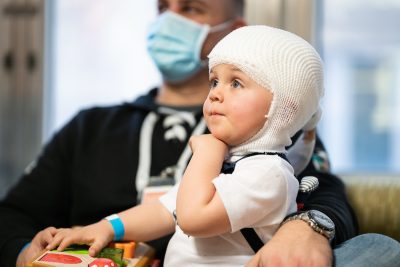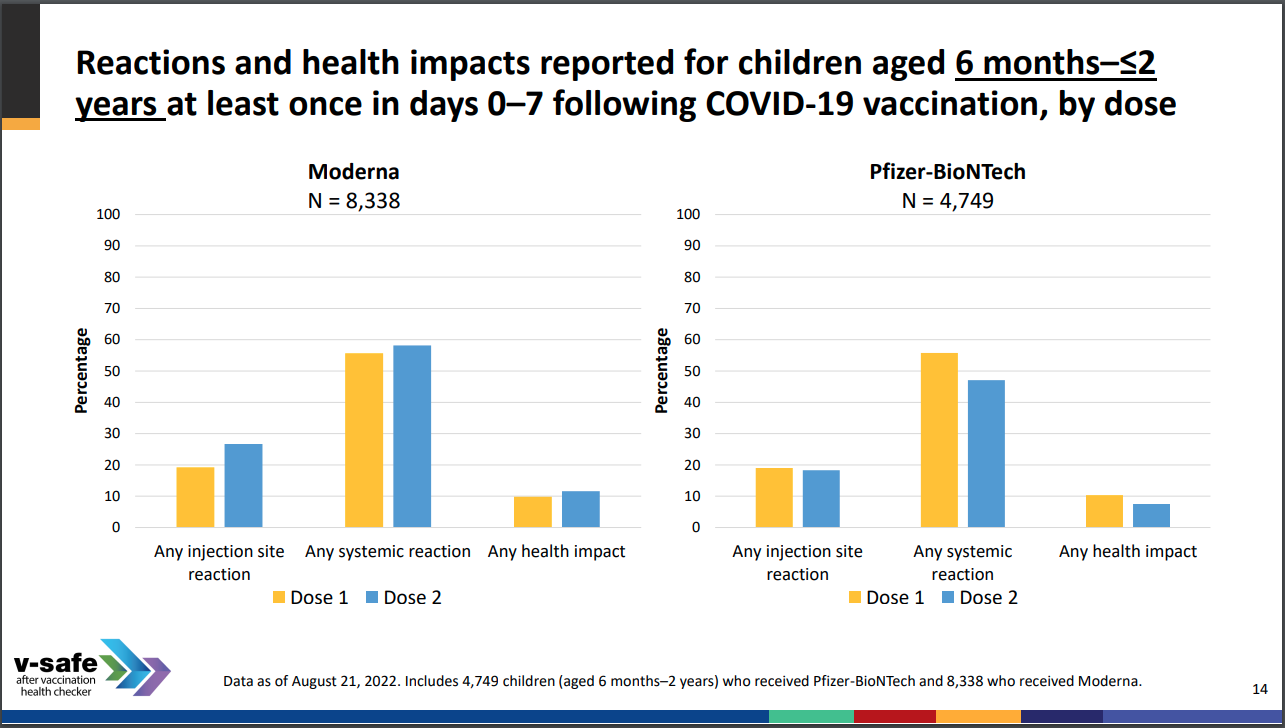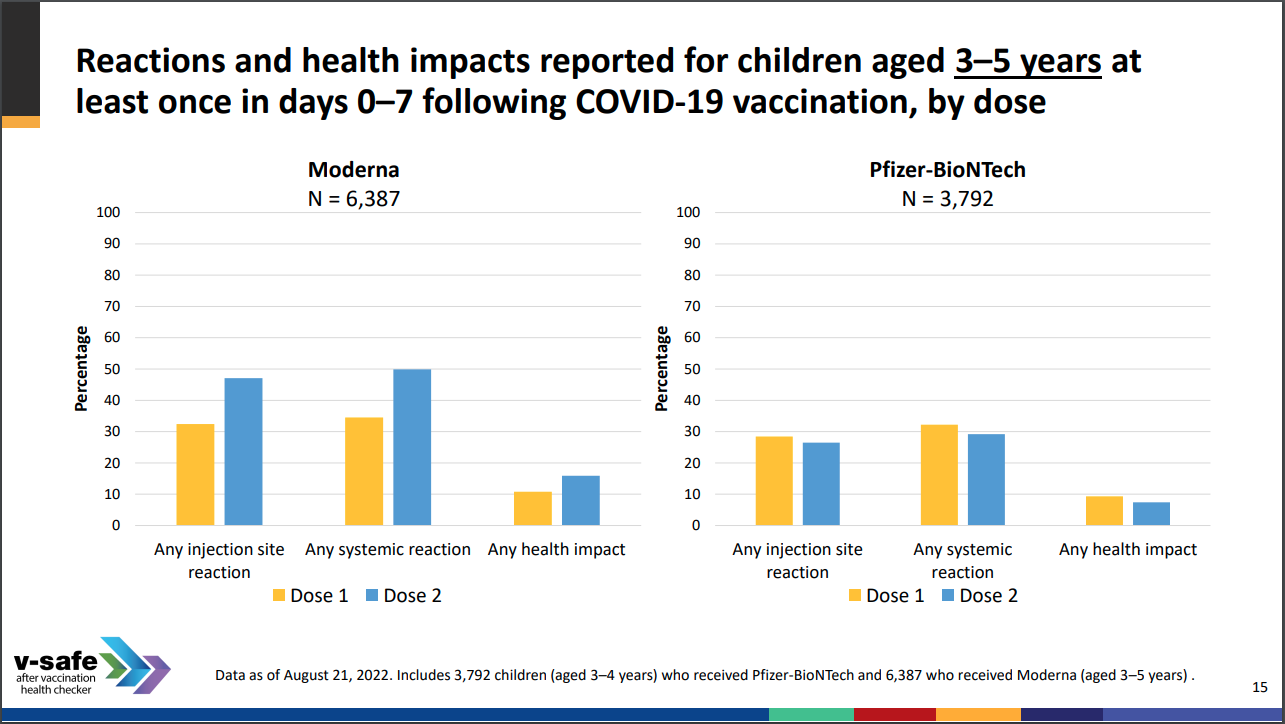CDC Survey: More Than Half of Babies, Toddlers Had ‘Systemic Reaction’ After COVID-19 Vaccine
Parents reported 6 percent of young children were unable to do normal activities after second dose

All Global Research articles can be read in 51 languages by activating the “Translate Website” drop down menu on the top banner of our home page (Desktop version).
To receive Global Research’s Daily Newsletter (selected articles), click here.
Follow us on Instagram and Twitter and subscribe to our Telegram Channel. Feel free to repost and share widely Global Research articles.
***
More than 55 percent of children ranging in age between 6 months and 2 years had a “systemic reaction” after their first dose of the Pfizer-BioNTech or Moderna COVID-19 vaccines, according to data released by the Centers for Disease Control and Prevention (CDC) on Sept. 1.
In addition, almost 60 percent had a reaction to the second dose of the Moderna vaccine, in the CDC survey of more than 13,000 children.
A systemic reaction is a response beyond the injection site. While the most common systemic reactions were fatigue, fever, irritability, and crying, parents of more than 6 percent of the children in the study said their child was unable to perform normal activities after the second dose of either the Pfizer-BioNTech or Moderna vaccine.
The CDC collected the data through a program called V-Safe—a smartphone-based monitoring system that operates through an app that parents download to their phones.
Between June 18 and Aug. 21, parents of more than 10,000 young children reported reactions to the CDC through V-Safe in the seven days after their child had received a COVID-19 vaccination.
Parents of 8,338 children ages 6 months to 2 years who received the Moderna vaccine reported information through V-Safe, with 55.7 percent reporting a systemic reaction after the first dose and about 58 percent after the second dose. For the Pfizer vaccine, parents of 4,749 children ages 6 months to 2 years submitted reports showing that 55.8 percent had a systemic reaction after the first dose and about 47 percent after the second dose of the vaccine.

The most frequently reported reactions for children 6 months to 2 years were irritability or crying, sleepiness, and fever. The most common reactions for children aged 3 to 5 years were injection site pain, fatigue, and fever.

Health Impacts
The data also showed a more serious reaction category labeled “any health impact.”
About 10 percent of all children 6 months to 2 years were reported to have a “health impact” after getting their first dose of either the Moderna or Pfizer vaccine. For the Moderna vaccine, slightly more children had a health impact after the second dose; for the Pfizer vaccine, it was slightly less.
The information was presented to the CDC’s Advisory Committee on Immunization Practices (ACIP) on Sept. 1 as part of an overview of all data related to the safety of COVID-19 vaccines.
In addition to V-Safe, data was presented summarizing reports from the Vaccine Adverse Event Reporting System (VAERS) and the Vaccine Safety Data Link (VSD), which includes data from several large health maintenance organizations in the United States.
All three systems look at the safety of vaccines after they’ve already gone to market and have been administered to large numbers of people.
Tom Shimabukuro, the head of the CDC’s vaccine safety team, headed the presentation and told committee members that no “statistical signals” of COVID-19 vaccine reactions were found for young children in the VSD data.
Shimabukuro also said that systemic reactions were “commonly reported” following vaccines.
However, other medical professionals such as Dr. Meryl Nass of Children’s Health Defense have expressed caution over the reported reactions, pointing to the high number of systemic reaction reports among very young children.
She told The Epoch Times on Sept. 2 that she was questioning why the government doesn’t collect and present more information on these cases.
“That stuff is not considered by the CDC to be very important … It’s assumed that all those side effects go away after a few days and leave the people perfectly well,” she said, mentioning the fevers and fatigue. “Those reactions may, in fact, be harbingers of more serious reactions, but nobody to my knowledge has published anything looking at whether these acute local or systemic reactions are indicators of a later problem.”
The FDA approved the emergency-use authorization of COVID-19 vaccines for children aged 6 months to 5 years on June 17. According to the CDC, about 599,460 children in that age group have received the Pfizer-BioNTech vaccine, and about 440,770 have received the Moderna vaccine.
From June 18 through Aug. 31, about 1 million doses of the Moderna and Pfizer vaccines were administered to children in this age group.
In a review of the VAERS data on young children from June 18 to Aug. 31, the CDC had 496 reports of adverse events for children aged 6 months to 4 years who received the Pfizer vaccine and 521 for children aged 6 months to 5 years who received the Moderna shot, with an adverse event defined as a possible side effect.
More than 98 percent of reports were for what the CDC considers non-serious events.
There are 220 reports of persons aged 5 months to 5 years of age being taken to the emergency room following a COVID-19 vaccine. In one case involving a 2-year-old boy in Arizona, the VAERS report says he was given the Pfizer vaccine on July 29 and on July 30 had a “life-threatening episode.”
The report lists his symptoms as “clammy skin and vomiting leading (8 minutes) to difficulty breathing.” The boy “turned blue,” was “limp” and “non-responsive,” and “fully stopped breathing for two minutes,” according to the report.
He was revived after chest compressions.
*
Note to readers: Please click the share buttons above or below. Follow us on Instagram and Twitter and subscribe to our Telegram Channel. Feel free to repost and share widely Global Research articles.
Featured image is from Steve Kirsch’s Newsletter
 The Worldwide Corona Crisis, Global Coup d’Etat Against Humanity
The Worldwide Corona Crisis, Global Coup d’Etat Against Humanity
by Michel Chossudovsky
Michel Chossudovsky reviews in detail how this insidious project “destroys people’s lives”. He provides a comprehensive analysis of everything you need to know about the “pandemic” — from the medical dimensions to the economic and social repercussions, political underpinnings, and mental and psychological impacts.
“My objective as an author is to inform people worldwide and refute the official narrative which has been used as a justification to destabilize the economic and social fabric of entire countries, followed by the imposition of the “deadly” COVID-19 “vaccine”. This crisis affects humanity in its entirety: almost 8 billion people. We stand in solidarity with our fellow human beings and our children worldwide. Truth is a powerful instrument.”
ISBN: 978-0-9879389-3-0, Year: 2022, PDF Ebook, Pages: 164, 15 Chapters
Price: $11.50
Purchase directly from the Global Research Online Store
You may also purchase directly at DonorBox “Worldwide Corona Crisis” Campaign Page! (NOTE: User-friendly)

